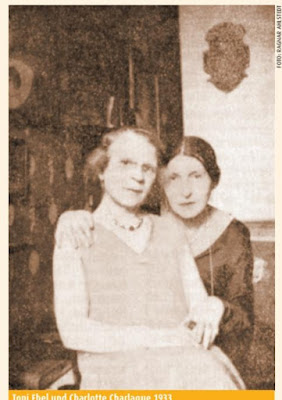Charlaque was born in Berlin-Schöneberg and raised with the name Curt Scharlach. There was a brother Hans, seven years older. The family, who were Jewish, emigrated to the US at the turn of the century and settled in San Francisco, where Edmund Scharlach worked as a sales representative in textiles. However the mother, Jenny, returned to Germany in 1910. Edmund, who had become a US citizen stayed and remarried in 1916.
Hans returned to Germany shortly after the start of the Great War in 1914. After 1919 he worked as an independent banker, until he sold his business in the mid-1920s. Curt worked briefly as a female impersonator, and consulted Harry Benjamin who suggested Magnus Hirschfeld in Berlin. Curt moved to Berlin in 1922 when Jenny was seriously ill, and lived with Hans for a while, but also spent time in France and became proficient in the language.
Increasingly Curt was rather Charlotte, and obtained a Transvestitenschein, to legally dress as the woman that she felt she was. She had completion surgery at the Am Urban hospital in Berlin-Kreuzberg in 1929-30, under the aegis of Magnus Hirschfeld’s Institut für Sexualwissenschaft. The surgery was done by Erwin Gohrbandt, and Felix Abraham paid the required 50 Reichsmarks. Like Dörchen Richter, Charlotte worked at the Institute, Dörchen as a maid, Charlotte as a receptionist. Her formal name was now Charlotte Curtis Charlaque.
Charlotte met
Toni Ebel and introduced her to Hirschfeld who accepted her into the surgical program. Toni had completion surgery in several operations in 1932. By that time Charlotte and Toni had become lovers. The Swedish journalist Ragnar Ahlstedt visited them at their flat at Nollendorfstraße 24 in Berlin-Schöneberg, and wrote about them in his
Män som blivit kvinnor, 1933. They lived cheaply: Charlotte said that she was an actress and Toni was able to sell some paintings and drawings.
Under Charlotte’s guidance, Toni converted to Judaism. In addition Toni had previously been a member of the Socialist USPD. After the Nazi takeover, one of Toni’s half sisters warned them that they were under observance, and they fled to Karlovy Vary (Karlsbad), in Czechoslovakia’s Sudetenland, the largest spa town in Europe, in May 1934. Charlotte gave English and French lessons, and Toni painted pictures for guests at the spa. The next year they moved to Prague and then to Brno. However they had to report to the police every fortnight and were advised to leave.
So they returned to Prague in 1938. Charlotte taught English and French and also gave acting courses and worked as a translator. She translated at least three stage works by the Czech writer Olga Scheinpflugová (1902-1968) into English. These are the dramas Chladné světlo (The Cold Light) , Láska není všecko (Love is not everything) and Pan Grünfeld a strašidla (Mr. Greenfeld and the Ghosts).
In March 1942 Charlotte was arrested by the Czechoslovak Aliens Police and jailed for being a Jew. Toni managed to persuade the Swiss consul that Charlotte was a US citizen, that she had submitted her documents to the US consul in Vienna and was waiting for a new passport. This resulted in Charlotte being sent to an “American camp” and later deported to the US. She sailed from Lisbon 2 July 1942. Toni attempted to follow but was not approved as Reichsdeutsche, and was not allowed to travel to Lisbon.
In New York Charlotte had to endure an extended medical exam. She was taken in by the Red Cross who housed her in a poor house in Leroy Street, Manhattan. She did some translations but suffered in her gallbladder and she had a stomach ulcer. She corresponded with Toni who settled in East Germany. She could not afford to return to Germany, and as a Jew was reluctant to do so. Later she made a living coaching young actors in “English diction”, and she also acted in several Off-Broadway productions, and was known for a while as the Queen of Brooklyn Heights Promenade. In December 1952 she wrote to Christine Jorgensen’s parents to explain that she too was transsexual.
- Ragnar Ahlstedt. Män som blivit kvinnor. Två fall av könsväxling på operative väg. En study of transvestitism. Tranås: mountain, 1933: 4.
- Joanne Meyerowitz. How Sex Changed: A History of Transsexuality in the United States. Harvard University Press. 2002: 30, 48, 294n53.
- Raimund Wolfert. “ ‘Sage, Toni, denkt man so bei euch drüben?’ Auf den Spuren von Curt Scharlach alias Charlotte Charlaque (1892 -?) und Toni Ebel (1881-1961)”. Lesbengeschichte, 3/2015. Online. And also at issuu.com Online.
- Raimund Wolfert. Charlotte Charlaque: Transfrau, Laienschauspielerin, „Königin der Brooklyn Heights Promenade“. Hentrich & Hentrich, 2021.
- Rivka Wolf. “Finding My Queer Heritage: My great-aunt Charlotte was trans and queer. Her story was lost to my family: until now”. Medium.com, Sep 14, 2021. Online.
DE.Wikipedia(Toni Ebel)
-----------
Two Nazi-era German films, Liebe geht - wohin sie will, 1935 and Junges Blut, 1936 feature an actor Hans Scharlach. It is not known whether this is Charlotte’s brother.
Wolfert says of the ‘American camp’ that it was “probably the Liebenau internment camp, which was set up in 1940 in a former sanatorium near Tettnang (Lake Constance district) in southern Germany. Foreign women and children from the entire German Reich or interned in areas occupied by the Wehrmacht, which were intended for exchange with Americans and British of German origin.”
Meyerowitz discusses Charlotte Charlaque under the pseudonym of Carla van Crist.
There is no mention of any Charlotte or ‘queen of Brooklyn Heights’ in Hugh Ryan’s When Brooklyn was Queer.






